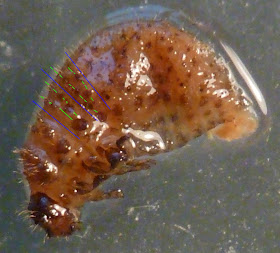If you are a regular here, you'll know I spend a lot of time peering closely at small invertebrates in order to identify them, like
here. For those interested in taxonomy and morphology (like me), that can be an end in itself - I find small creatures fascinating and I like to know what they are. I geek them, and do so proudly - plus I'm a professional entomologist/ecologist so there's the academic-kudos and getting-paid aspects. However, there is more to it than that.
I have been asked more than once why we need to identify species - and it's a fair question; after all, the beetles don't care whether we can name them, and individual ones would probably prefer not to be fatally sampled for the greater good. However, without identification (which often requires a dead specimen), there can be no survey, monitoring or collection of distribution data; and without these, we don't know what needs conservation effort. In an ideal world, their habitats would be fine, biodiversity would not be threatened, and conservation (if needed given the previous points!) would have limitless funding. Sadly these things are very very much not the case. So, samples are taken, species are identified (along with date, location etc) and data sent to recording schemes/centres, or now added to online systems such as
iRecord to be validated by hard-working volunteers such as myself...
Once the data has made its way to the recording scheme database, it can be downloaded, interrogated - in short,
used. This could be for any number of purposes - planning, research, amatuer interest, and so on. However, during the winter of 2013/14 I was lucky enough to be contracted to use this data to write a status review of the Chrysomelidae (leaf beetles), the group I specialise in. This meant looking at the change in distribution of all the British species and allocating them to categories such as 'Least Concern', 'Endangered' and 'Vulnerable'. Thus, scarce and threatened species could be identified and highlighted with extra information focusing on these, such as summaries of habitats, distribution, threats and conservation measures. This is important as it will inform conservation efforts, survey work, policy decisions and other activities. It's also part of a wider project with different specialists covering their groups of choice such as Carabidae (ground beetles) and is a major update to status review work published in the 1990s (e.g. Hyman & Parsons, 1992) some of which is now considerably out of date.
I won't go into any more detail here, but if you want to look at the report, it's called
A review of the scarce and threatened beetles of Great Britain: The leaf beetles and their allies and is free to download
here along with data covering the key species.
ReferenceHyman, P.S. & Parsons, M.S. (1992).
A review of the scarce and threatened Coleoptera of Great Britain 1. JNCC, Peterborough.





